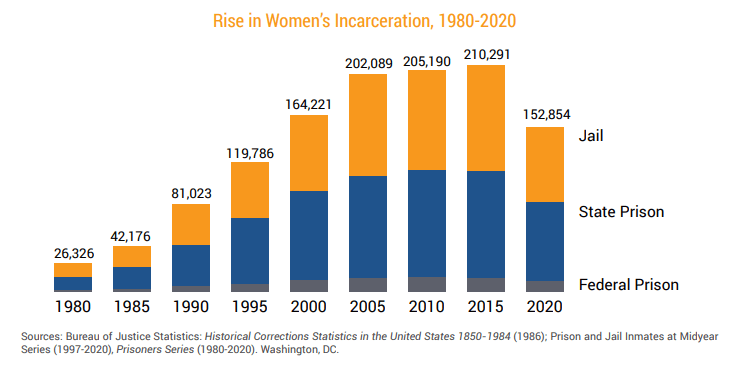Just the Facts - The Increased Rates of Incarceration of Women and Girls
Between 1980 and 2020, the number of incarcerated women increased by more than 475%

In contrast to the total number of incarceration persons, where the state prison systems hold twice as many people as are held in jails, more incarcerated women are held in jails than in state prisons, and the outsized role of jails has serious consequences for incarcerated women and their families.
Women’s incarceration has grown at twice the pace of men’s incarceration in recent decades, and has disproportionately been located in local jails. Unfortunately, the data needed to explain exactly what happened, when, and why does not yet exist, largely because the data on women has long been obscured by the larger scale of men’s incarceration.
A staggering number of women who are incarcerated are not even convicted: a quarter of women who are behind bars have not yet had a trial. 60% of women in jails under local control have not been convicted of a crime and are awaiting trial. Avoiding pre-trial incarceration is uniquely challenging for women. largely because incarcerated women, who have lower incomes than incarcerated men, have an even harder time affording money bail. When the typical bail amounts to a full year’s income for women, it’s no wonder that women are stuck in jail awaiting trial.
What does it mean that large numbers of women are held in jail and the impact and for families? While stays in jail are generally shorter than in stays in prison, jails make it harder to stay in touch with family than prisons do. Jail phone calls are three times as expensive as calls from prison. Other forms of communication are more restricted, as some jails don’t even allow real letters, limiting mail to postcards. This is especially troubling as over half (58%) of women in jails are mothers and most of those are primary caretakers of their children, who are then vulnerable to the shared effects of burdens placed in incarcerated women.
Other facts about women's incarceration rates:
- • In 2020, the imprisonment rate for Black women (65 per 100,000) was 1.7 times the rate of imprisonment for white women (38 per 100,000). • Latinx women were imprisoned at 1.3 times the rate of white women (48 vs. 38 per 100,000). • The rate of imprisonment for Black and Latinx women has declined since 2000, while the rate of imprisonment for white women has increased. • Between 2000 and 2020, the rate of imprisonment in state and federal prisons declined by 68% for Black women, while the rate of imprisonment for white women rose by 12%.
- • Women in state prisons are more likely than men to be incarcerated for a drug or property offense. Twenty-six percent of women in prison have been convicted of a drug offense, compared to 13% of men in prison; 23% of incarcerated women have been convicted of a property crime, compared to 15% among incarcerated men.
- The proportion of imprisoned women convicted of a drug offense has increased from 12% in 1986 to 26% in 2019.
- African American and Tribal girls are much more likely to be incarcerated than Asian, white, and Latinx girls. The placement rate for all girls is 35 per 100,000 girls (those between ages 10 and 17), but the placement rate for Asian girls is 4 per 100,000; for white girls is 24 per 100,000; and Latinx girls is 27 per 100,000. African American girls are more than three times as likely as their white peers to be incarcerated (77 per 100,000), and Tribal girls are more than four times as likely (112 per 100,000).
You can download the PDF fact sheet of The Sentencing Project's report on Incarcerated Women and Girls.










